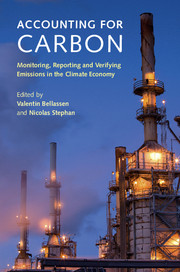Book contents
- Frontmatter
- Contents
- List of figures and map
- List of tables
- List of boxes
- Notes on contributors
- Acknowledgements
- 1 Introduction: key notions and trade-offs involved in MRVing emissions
- Part I MRV of territorial/jurisdictional emissions
- 2 Trendsetter for territorial schemes: national GHG inventories under the UNFCCC
- 3 Variant 1: region/city geographical inventories
- 4 Variant 2: sectoral MRV at the jurisdictional level–forestry (REDD+) in the VCS and the UNFCCC
- Part II MRV of industrial sites and entities
- Part III MRV at offset project scale
- Index
- References
3 - Variant 1: region/city geographical inventories
from Part I - MRV of territorial/jurisdictional emissions
Published online by Cambridge University Press: 05 March 2015
- Frontmatter
- Contents
- List of figures and map
- List of tables
- List of boxes
- Notes on contributors
- Acknowledgements
- 1 Introduction: key notions and trade-offs involved in MRVing emissions
- Part I MRV of territorial/jurisdictional emissions
- 2 Trendsetter for territorial schemes: national GHG inventories under the UNFCCC
- 3 Variant 1: region/city geographical inventories
- 4 Variant 2: sectoral MRV at the jurisdictional level–forestry (REDD+) in the VCS and the UNFCCC
- Part II MRV of industrial sites and entities
- Part III MRV at offset project scale
- Index
- References
Summary
Introduction
Greenhouse gas inventories and related measurement tools for quantifying emissions at the scale of a given territory or territory or administrative area can play an important role in local-scale climate action. These tools can assist in a number of mandated and statutory strategic planning exercises, the development and provision of public services (transport, energy, waste) and provide a means for authorities to monitor changes in emission levels of all actors under their jurisdiction.
As of August 2013, no obligatory territorial-scale monitoring, reporting and verification of greenhouse gas emissions has been implemented at a subnational level. A number of different reasons may explain why no formal MRV of subnational territorial GHG emissions has been implemented with local governments instead implementing proactive, voluntary measures. First, local governments are not able to directly control the majority of the emissions under their jurisdiction, thus within the political economy of GHG management, subnational governments are unlikely to fully accept formal (and potentially binding) responsibility for actions beyond their direct control. Second, GHG inventories are increasingly being used as planning and management tools. However, to date the quantification of territorial emissions and their management at the subnational level remains disconnected from formalized measuring and reporting systems such as binding subnational GHG mitigation objectives, national GHG inventories or the creation of monetized or fungible assets. As such, there is little incentive for actors to produce a full MRV given the limited added-value (access to finance, etc.) compared to potentially increased costs.
Nevertheless, over the last 15 years a wide variety of voluntary tools have been developed and implemented across the globe. While formalized MRV systems have not been put into place, different measuring and reporting frameworks and protocols have been developed with a number of efforts to foster harmonization across nations and continents. The different frameworks often are directly linked to national (Bilan Carbone® Territorial and PCIT in France), regional (Covenant of Mayors – see below) or “niche” markets dominated by different city-based networks (ICLEI C-40).
- Type
- Chapter
- Information
- Accounting for CarbonMonitoring, Reporting and Verifying Emissions in the Climate Economy, pp. 72 - 103Publisher: Cambridge University PressPrint publication year: 2015
References
- 3
- Cited by

